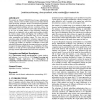7 search results - page 1 / 2 » Secure Location Verification - A Security Analysis of GPS Si... |
DBSEC
2010
13 years 6 months ago
2010
The use of location based services has increased significantly over the last few years. However, location information is only sparsely used as a security mechanism. One of the reas...
ICDCS
2005
IEEE
13 years 10 months ago
2005
IEEE
Sensors’ locations play a critical role in many sensor network applications. A number of techniques have been proposed recently to discover the locations of regular sensors base...
MMSEC
2006
ACM
13 years 10 months ago
2006
ACM
We present an efficient JPEG2000-based image authentication scheme, which is robust to JPEG compression and other allowed signal processing operations. Positive wavelet-based wate...
SCN
2008
Springer
13 years 4 months ago
2008
Springer
Relative location information helps build vehicle topology maps. Such maps provide location information of nearby vehicles to drivers. In building a vehicle topology, one must cons...
WORM
2003
13 years 6 months ago
2003
This paper presents DOME, a host-based technique for detecting several general classes of malicious code in software executables. DOME uses static analysis to identify the locatio...

